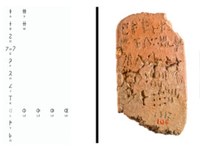A new approach to the interpretation of fraction signs in the Linear A script
By combining palaeographic examination and highly sophisticated computational approaches, a research group at the University of Bologna developed an innovative method that might solve one of the greatest mysteries of undeciphered ancient writing systems.

The Journal of Archaeological Science has recently published a paper reporting about the work of a research group at the University of Bologna that provides new insight into the mystery of number writing in ancient times: the fraction sign in the Linear A script, the undeciphered writing system of the Minoan Civilization.
Researchers looked at the shape of the signs and their use in the ancient inscriptions. Then, they used these observations to inform analyses that employed statistics, computational and typological strategies. In this way, they developed a multi-stranded method for the systematic assignment of mathematical values to Linear A fraction signs.
"To solve this mystery, we combined and exploited research tools that are rarely used in synergy. On the one hand, a close palaeographical analysis of the signs; on the other hand, computational, statistical, and typological strategies" explains Silvia Ferrara, who led the research and is also a professor at the University of Bologna. "This led us to gain a new perspective on this issue. Hopefully, it will also lead us to obtain different but equally important information".
3,500 years ago, the Minoan Civilization on the island of Crete conceived a writing system of hundreds of signs that are believed to be syllabic and that are known today as Linear A script. Minoans used this system to write inscriptions on voting offerings in temples or as embellishments for jewels. However, they primarily used the Linear A script for administrative purposes in palace writings.
This explains why this writing system, that is still largely undeciphered, contains complex numeric modes with signs indicating numbers as units but also fractions (e.g. 1/2, 1/4, 1/8 and so on). While the signs indicating numbers as units have long been deciphered, those indicating fractions remain an unsolved riddle.
"Two main issues have so far prevented the deciphering of these signs", says Silvia Ferrara. "On the one hand, all the documents containing a sum of fractions and its resulting number are damaged or difficult to interpret. On the other hand, we observed some conflicting ways of using the signs. This led us to think that the notation system evolved throughout the centuries".
Hence, the researchers decided to focus on the study of clay tablets and other documents dating to a specific period between 1,600 BC and 1,450 BC, when the notation system seemed to be coherent across the island of Crete.
Then, they applied computational methods to the identification of symbols and their corresponding values within the fractions. This made it possible for them to rule out unfeasible solutions. They restricted the feasible solutions that remained after this process - approximately 4 mln combinations - through statistical calculations and a comparative analysis of fractions in ancient writing systems. Finally, they made a hypothesis about the sign-value correspondence by considering the inherent coherence of the system itself.
As a result, they obtained a system which presents 1/60 as lowest value and, therefore, most values are recorded in a span from one to 60. Their results bear relevance to another writing system: the Linear B used within the Mycenaean Civilization between 1,450 BC and 1,200 BC.
"Our data show how the Mycenaen Linear B and the Linear A script share some fractions to express precise units of measure", says Silvia Ferrara. "For example, the sign meaning 1/10 in the Linear A script is also found in the Linear B. In the Linear B, this sign indicates a measurement unit for dry products and corresponds to 1/10 of a larger measure. This proves a historical continuity among the two civilizations in the use of writing systems, from fractions to units of measure".
This study was published in the Journal of Archaeological Science and its title is "The mathematical values of fraction signs in the Linear A script: A computational, statistical and typological approach”. It was carried out by Michele Corazza, Barbara Montecchi, Miguel Valério and Fabio Tamburini and led by Silvia Ferrara, who are all members of the ERC project INSCRIBE. INSCRIBE (Invention of Scripts and their Beginnings) focuses on the factors that made the invention of writing possible in different parts of the world.
